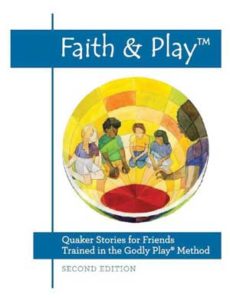Faith and Play: Quaker Stories for Friends Trained in the Godly Play Method (Second Edition)
Reviewed by Claire J. Salkowski
November 1, 2018
 By the Faith and Play Group, edited by Melinda Wenner Bradley. QuakerPress of FGC, 2017. 140 pages. $20/paperback.
By the Faith and Play Group, edited by Melinda Wenner Bradley. QuakerPress of FGC, 2017. 140 pages. $20/paperback.
Buy from QuakerBooks
How do we help children develop their own relationship with the Divine and encourage their spiritual and faith formation? In many Quaker meetings, the question of how to make the children’s First-day program relevant, inspiring, and effective is often a topic of discussion. The task of choosing an approach or curriculum can be daunting, as many fine curricula abound. In my preparation to review the book and program known as Faith and Play/Godly Play, I have discovered that there are many questions that deserve exploration before a thoughtful decision can be made. As a meeting, we need to explore our deepest philosophy of education and how we want it to manifest in the religious education of our children.
As a lifelong Montessorian and a Quaker for most of my adult life, I was immediately drawn to this book and delighted to find an intersection between two areas in my life that are critically important to me. I also found it useful to trace the history of this approach in order to understand the context in a deeper and more informed way.
Faith and Play for Quakers grew out of the experience that Friends had with the Godly Play curriculum approach which is rooted in Montessori principles and evolved in many ways from the original work of Sofia Cavalletti and her Montessori collaborator, Gianna Gobbi. Cavalletti was introduced to Gobbi after having been asked to teach religion at a Montessori school in Rome where she lived and worked as a Hebrew and religious scholar. Together they developed the Catechesis of the Good Shepherd in 1954 with the goal of helping children to have “a living encounter with the living God.” Jerome Berryman, a Montessorian himself as well as graduate of Princeton Theological Seminary, was a friend of and in many ways influenced by Dr. Cavalletti. He published his first Godly Play curriculum in 2002.
Each of these approaches is grounded in Montessori principles that have successfully guided the education of children around the world for more than 100 years. Based on the belief that children are their own best teachers and that the adult should be a guide rather than the purveyor of knowledge, Maria Montessori advocated that children should be afforded the independence and freedom of movement, within a carefully prepared environment, to follow their interests and discover learning according to their own developmental time table.
In each of these curricula, children are encouraged to experience the presence of God in their own lives by directly experiencing and pondering stories of faith in a tangible and hands-on way, which is a core component of the Montessori method. As written in the introduction to Faith and Play, it is a “story-based curriculum focused on building spiritual community with children and offering them images and language to express their wonder and experience of the Divine.” As a specifically Quaker work, authored by six members of the Faith and Play Group, this second edition text offers children the opportunity to explore explicit Quaker tenets such as “continuing revelation; multiple perspectives on a story; silence, reflection, and corporate sharing as valuable components of the spiritual life; and the diversity of ways the Spirit works within each person.” While other curricula are solidly based on Bible stories from both the Old and New Testaments, this work contains stories on Quaker faith and practice as well as “some Bible content told in ways that reflect Quaker sensibilities.” It is noted that these stories are meant to be used in conjunction with Godly Play, and it is highly recommended by the authors that specific training occur before either curriculum is implemented.
Faith and Play is divided into sections that cover basic Quaker faith and practice, such as images and symbols of the Divine; meeting for worship and meeting for business; our individual and corporate role in meeting; and queries, as well as stories related to the testimonies and stories of witness that highlight such weighty Quakers as George Fox, Margaret Fell, Mary Fisher, John Woolman, and Elizabeth Fry. It also includes “An Easter Story for Friends” as well as appendices which minutely detail how to create the materials for use with the stories and manage the details of the lesson, using the circle and time for the children to do their own work.
As an educator of children for many years, I know that we serve children best when we provide the right environment and gentle support that allows them a truly experiential way to listen, reflect, and seek answers to questions they formulate for themselves. Spiritual development and the evolution of faith is deeply personal and begins in the early years. This book gives the reader a detailed way of offering such a gift to the children in our meetings.
1 thought on “Faith and Play: Quaker Stories for Friends Trained in the Godly Play Method (Second Edition)”
Leave a Reply
Comments on Friendsjournal.org may be used in the Forum of the print magazine and may be edited for length and clarity.



I really enjoyed the review of “Faith and Play: Quaker Stories for Friends Trained in the Godly Play Method (Second Edition)” in the November 2018 issue. I want to share another resource for those working with children and play. Healthy Play Is A Solution is a program that utilizes play activities to build positive character in children. They offer training programs for professionals and in-classroom demonstrations with children, and the book “Learning to Play, Playing to Learn” is full of play activities that can be used in educational and spiritual environments to build character. Their website is: healthy-play.com.